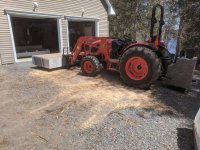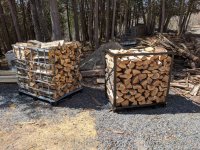PEJ5
Gold Member
I am very very happy with my Kioti but there are a couple of areas where Kioti (the company) is disappointing. First, they will not post their manuals and documentation as PDFs. It's 2020 already. Second, is the subject of this post...Kioti does not share useful loader lift specs such as a graph of lift capacity 500mm beyond pins. The only thing they quote is at the pins. Who lifts at the pins? How much can my 2660lb capacity loader actually lift?
For Kioti owners it becomes a trial and error thing. Will I actually be able to unload that delivery that is coming this afternoon?!? In my case the answer was no. I was receiving a load of sheetrock and each "lift" was 40 sheets@1800lbs, well below the quoted 2660 at the pins at max height. The truck bed was about 4' high and the top lift was 2' above that (6'/1.8m). I could raise the 1800lbs at 6 feet (and rear tires stayed on the ground), but could not curl the forks to keep the load level. We had to reduce the number of sheets.
To be fair, I will admit and agree that most of the time I have no idea how much the load weighs so it is a case of "let's just try it". With my tractor and forks, I am excited to now be able to rank firewood on pallets so I can move it around and reduce the number of times firewood heats me up . How big a pile can I lift? The IBC tote full of very green maple was not problem. I calculated the load to be 1/3 of a cord and with a useful shared chart (Kioti, if you are reading, it was a PDF ;-), I estimate the load to be 1500lbs. I thought about raising it to 6' and trying to curl, but I did not want firewood on my hood and lap!!
. How big a pile can I lift? The IBC tote full of very green maple was not problem. I calculated the load to be 1/3 of a cord and with a useful shared chart (Kioti, if you are reading, it was a PDF ;-), I estimate the load to be 1500lbs. I thought about raising it to 6' and trying to curl, but I did not want firewood on my hood and lap!!
Beyond my rant, is 1800lbs a reasonable maximum at 6 feet for a 2660lb capacity loader. Does anyone else have good examples of hitting the maximum? Here is a photo of my 30 sheets and firewood seasoning in the sun.


For Kioti owners it becomes a trial and error thing. Will I actually be able to unload that delivery that is coming this afternoon?!? In my case the answer was no. I was receiving a load of sheetrock and each "lift" was 40 sheets@1800lbs, well below the quoted 2660 at the pins at max height. The truck bed was about 4' high and the top lift was 2' above that (6'/1.8m). I could raise the 1800lbs at 6 feet (and rear tires stayed on the ground), but could not curl the forks to keep the load level. We had to reduce the number of sheets.
To be fair, I will admit and agree that most of the time I have no idea how much the load weighs so it is a case of "let's just try it". With my tractor and forks, I am excited to now be able to rank firewood on pallets so I can move it around and reduce the number of times firewood heats me up
 . How big a pile can I lift? The IBC tote full of very green maple was not problem. I calculated the load to be 1/3 of a cord and with a useful shared chart (Kioti, if you are reading, it was a PDF ;-), I estimate the load to be 1500lbs. I thought about raising it to 6' and trying to curl, but I did not want firewood on my hood and lap!!
. How big a pile can I lift? The IBC tote full of very green maple was not problem. I calculated the load to be 1/3 of a cord and with a useful shared chart (Kioti, if you are reading, it was a PDF ;-), I estimate the load to be 1500lbs. I thought about raising it to 6' and trying to curl, but I did not want firewood on my hood and lap!!Beyond my rant, is 1800lbs a reasonable maximum at 6 feet for a 2660lb capacity loader. Does anyone else have good examples of hitting the maximum? Here is a photo of my 30 sheets and firewood seasoning in the sun.

